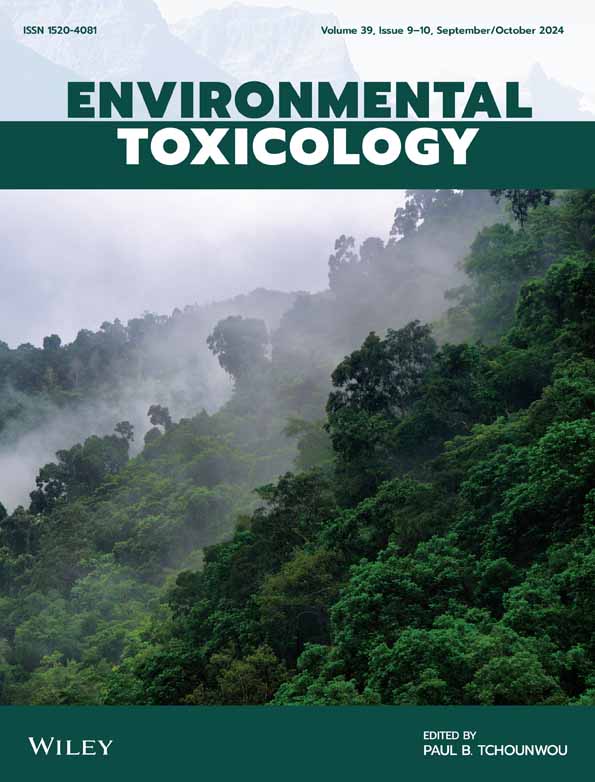2-Ethyl-Hexyldiphenyl Phosphate (EHDPP) Induces Cytotoxicity by Activation of Autophagy Process in HepG2 Cells.
IF 3.2
3区 医学
Q2 ENVIRONMENTAL SCIENCES
引用次数: 0
Abstract
Organophosphate flame retardants (OPFRs) are extensively used in the electronics industry, plastics, textiles, and other sectors to reduce flammability and enhance fire safety. However, excessive OPFR use has led to significant environmental accumulation, increasing ecological stress and potential human health risks. This study investigates the effects of 2-ethylhexyldiphenyl phosphate (EHDPP) on HepG2 cells, demonstrating that EHDPP exposure impairs normal cellular function through excessive autophagy, ultimately reducing cell viability. Our findings reveal a concentration-dependent decline in cell survival, with an LC50 of 120 μM. While lower concentrations (0, 1, 5, 10, and 50 μM) exerted minimal effects, 50 μM EHDPP significantly reduced cell viability. Further analysis confirmed that EHDPP exposure upregulates autophagy-related genes (ATG5, ATG12, VPS34, Beclin1, FIP200, ATG13, and ATG3), leading to an increased LC3-II/I ratio and a decrease in p62 levels, indicative of enhanced autophagic activity. Transmission electron microscopy (TEM) imaging confirmed a substantial increase in autophagosome formation at 50 μM EHDPP. These results provide new insights into the cytotoxic mechanisms of EHDPP, emphasizing its role in triggering excessive autophagy in hepatic cells.2-乙基己基二苯基磷酸(EHDPP)通过激活HepG2细胞自噬过程诱导细胞毒性。
有机磷阻燃剂(OPFRs)广泛应用于电子工业、塑料、纺织和其他行业,以降低可燃性和提高防火安全性。然而,OPFR的过度使用导致了显著的环境积累,增加了生态压力和潜在的人类健康风险。本研究探讨了2-乙基己基二苯基磷酸(EHDPP)对HepG2细胞的影响,证明EHDPP暴露通过过度自噬损害正常细胞功能,最终降低细胞活力。我们的发现揭示了浓度依赖性的细胞存活率下降,LC50为120 μM。虽然较低浓度(0、1、5、10和50 μM)对细胞的影响很小,但50 μM EHDPP显著降低了细胞活力。进一步分析证实,EHDPP暴露可上调自噬相关基因(ATG5、ATG12、VPS34、Beclin1、FIP200、ATG13和ATG3),导致LC3-II/I比值升高,p62水平降低,表明自噬活性增强。透射电镜(TEM)成像证实,在50 μM EHDPP下,自噬体的形成显著增加。这些结果为EHDPP的细胞毒性机制提供了新的见解,强调了其在引发肝细胞过度自噬中的作用。
本文章由计算机程序翻译,如有差异,请以英文原文为准。
求助全文
约1分钟内获得全文
求助全文
来源期刊

Environmental Toxicology
环境科学-毒理学
CiteScore
7.10
自引率
8.90%
发文量
261
审稿时长
4.5 months
期刊介绍:
The journal publishes in the areas of toxicity and toxicology of environmental pollutants in air, dust, sediment, soil and water, and natural toxins in the environment.Of particular interest are:
Toxic or biologically disruptive impacts of anthropogenic chemicals such as pharmaceuticals, industrial organics, agricultural chemicals, and by-products such as chlorinated compounds from water disinfection and waste incineration;
Natural toxins and their impacts;
Biotransformation and metabolism of toxigenic compounds, food chains for toxin accumulation or biodegradation;
Assays of toxicity, endocrine disruption, mutagenicity, carcinogenicity, ecosystem impact and health hazard;
Environmental and public health risk assessment, environmental guidelines, environmental policy for toxicants.
 求助内容:
求助内容: 应助结果提醒方式:
应助结果提醒方式:


